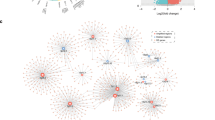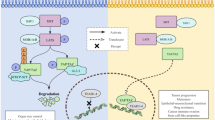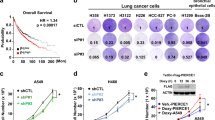Abstract
Non small cell lung cancer (NSCLC) is the leading cause of cancer deaths in the United States and worldwide. Unfortunately, standard therapies remain inadequate. An increased understanding of the molecular biology of lung cancer biology is required to develop more effective new therapies. In this report, we show that the Wnt pathway is activated through Dishevelled (Dvl) overexpression in NSCLC. Analysis of freshly resected tumors and lung cancer cell lines demonstrate that Dvl-3, a critical mediator of Wnt signaling, is overexpressed. Specifically, Dvl-3 was overexpressed significantly in 75% of fresh NSCLC microdissected samples compared to control paired matched normal lung samples. To evaluate the biological significance of Wnt signaling and, in particular, Dvl function in lung cancer, we transfected siRNA (designed to inhibit selectively human Dvl-1, -2, and -3), to the NSCLC cell line H1703, which is known to have β-catenin-mediated Tcf-dependent transcriptional activity. Here, we demonstrate that Dvl-specific siRNA treatment in H1703 decreases significantly Dvl and β-catenin expression, resulting in reduction of Tcf-dependent transcriptional activity, and, importantly, growth inhibition. Taken together, these data support the novel hypothesis that Dvl overexpression is critical to Wnt signaling activation and cell growth in NSCLC.
This is a preview of subscription content, access via your institution
Access options
Subscribe to this journal
Receive 50 print issues and online access
$259.00 per year
only $5.18 per issue
Buy this article
- Purchase on Springer Link
- Instant access to full article PDF
Prices may be subject to local taxes which are calculated during checkout




Similar content being viewed by others
References
Brantjes H, Barker N, van Es J and Clevers H . (2002). Biol. Chem., 383, 255–261.
Brognard J and Dennis PA . (2002). Cell Death Differ., 9, 893–904.
Cagatay T and Ozturk M . (2002). Oncogene, 21, 7971–7980.
Hommura F, Furuuchi K, Yamazaki K, Ogura S, Kinoshita I, Shimizu M, Moriuchi T, Katoh H, Nishimura M and Dosaka-Akita H . (2002). Cancer, 94, 752–758.
Li L, Mao J, Sun L, Liu W and Wu D . (2002). J. Biol. Chem., 277, 5977–5981.
Liu J, Stevens J, Rote CA, Yost HJ, Hu Y, Neufeld KL, White RL and Matsunami N . (2001). Mol. Cell, 7, 927–936.
Matsuzawa SI and Reed JC . (2001). Mol. Cell, 7, 915–926.
Minna JD . (1998). Harrison's Principles of Internal Medicine Vol. 14. Fauci AS, Braunwald E, Isselbacher KJ, Martin JB (eds). McGraw-Hill: New York, pp. 522–562.
Morin PJ . (1999). BioEssays, 21, 1021–1030.
Polakis P . (2000). Genes Dev., 14, 1837–1851.
Sekido Y, Fong KM and Minna JD . (1998). Biochim. Biophys. Acta, 1378, F21–F59.
Shimizu H, Julius MA, Giarre M, Zheng Z, Brown AM and Kitajewski J . (1997). Cell Growth Differ., 8, 1349–1358.
Sunaga N, Kohno T, Kolligs FT, Fearon ER, Saito R and Yokota J . (2001). Genes Chromosom. Cancer, 30, 316–321.
Ueda M, Gemmill RM, West J, Winn R, Sugita M, Tanaka N, Ueki M and Drabkin HA . (2001). Br. J. Cancer, 85, 64–68.
Wang J, Shou J and Chen X . (2000). Oncogene, 19, 1843–1848.
Wharton Jr KA . (2003). Dev. Biol., 253, 1–17.
Winn RA, Bremnes RM, Bemis L, Franklin WA, Miller YE, Cool C and Heasley LE . (2002). Oncogene, 21, 7497–7506.
You L, Uematsu K, McBrine MJ, McCormick F and Jablons DM . (2001). Proc. Am. Assoc. Cancer Res., 42, 609.
Author information
Authors and Affiliations
Corresponding author
Rights and permissions
About this article
Cite this article
Uematsu, K., He, B., You, L. et al. Activation of the Wnt pathway in non small cell lung cancer: evidence of dishevelled overexpression. Oncogene 22, 7218–7221 (2003). https://doi.org/10.1038/sj.onc.1206817
Received:
Revised:
Accepted:
Published:
Issue Date:
DOI: https://doi.org/10.1038/sj.onc.1206817
Keywords
This article is cited by
-
CYP2E1 plays a suppressive role in hepatocellular carcinoma by regulating Wnt/Dvl2/β-catenin signaling
Journal of Translational Medicine (2022)
-
Radiomics and gene expression profile to characterise the disease and predict outcome in patients with lung cancer
European Journal of Nuclear Medicine and Molecular Imaging (2021)
-
Cancer cell-intrinsic function of CD177 in attenuating β-catenin signaling
Oncogene (2020)
-
Acetylation of conserved DVL-1 lysines regulates its nuclear translocation and binding to gene promoters in triple-negative breast cancer
Scientific Reports (2019)
-
A Ras destabilizer KYA1797K overcomes the resistance of EGFR tyrosine kinase inhibitor in KRAS-mutated non-small cell lung cancer
Scientific Reports (2019)



